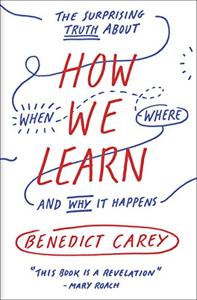
Want to learn the ideas in How We Learn better than ever? Read the world’s #1 book summary of How We Learn by Benedict Carey here.
Read a brief 1-Page Summary or watch video summaries curated by our expert team. Note: this book guide is not affiliated with or endorsed by the publisher or author, and we always encourage you to purchase and read the full book.
Video Summaries of How We Learn
We’ve scoured the Internet for the very best videos on How We Learn, from high-quality videos summaries to interviews or commentary by Benedict Carey.
1-Page Summary of How We Learn
Overview
Benedict Carey’s book, How We Learn: The Surprising Truth About When, Where, and Why It Happens (2015), discusses why the brain learns best. He provides counterintuitive advice about how to study effectively.
Students are taught that the best way to study is to find a quiet place, focus intensely and repeatedly review information they need to memorize. They’re told that forgetting or being distracted while learning something new is bad. However, studies show this isn’t true at all; in fact, it’s good for us.
Learning is best when it’s messy and interrupted. It works better if you forget things, so that you have to work harder to recall them. Spacing out your study sessions makes the brain forget a little bit less each time, which helps it remember more when needed. Combining different problem types in one session forces the brain to make new connections between problems and build stronger neural networks around those memories. This way of studying can also help students learn multiple associations with the studied material, which will help them retain more information for longer periods of time.
Some learning techniques don’t require much effort and are actually more effective than others. For example, taking breaks lets the brain subconsciously make connections and eliminate distractions. Sleeping is another good way to learn because it allows the material learned throughout the day to be synthesized at night as you dream.
The body’s sensory system picks up cues to help it learn patterns and categories. This can be useful in many contexts, such as chemistry, music or art history. A less rigorous study regimen with long breaks appears to work better than a disciplined one that requires days on end at the library stacks. The more disorganized routine helps establish and maintain a balanced life.
Key Point 1: Forgetting helps the brain learn.
When we forget something, it makes the information easier to remember. For example, when you cram for a test and then don’t use that information again for a while, you’re more likely to remember it later on because your brain has had time to process that information.
Forgetting may be helpful in helping people remember things, as well as aiding the creative thinking process. In a study by the Journal of Experimental Psychology, participants were given objects and asked to come up with uses for them. When they were instructed to forget some of those uses, they came up with more creative answers than when they weren’t told to forget anything. The researchers concluded that forgetting allows less useful information to fade away so it doesn’t get in the way of new ideas.
Key Point 2: Varying the study location or making changes within the study environment helps students retain information.
Research shows that people can remember information better when they’re tested in the same place where they learned it. This is because the information becomes intertwined with their surroundings, such as sights and sounds. Although this isn’t always possible, a student can manipulate his or her study environment to improve learning by increasing the number of perceptions associated with that material. By varying the circumstances in which we learn something new, we create a stronger neural web around our memory for that material.
A study conducted in the UK found that classroom design can have a significant impact on academic performance. The study surveyed elementary schools over two years and concluded that natural light, flexibility of the environment, and color were all important factors for student progress. Students who had access to nature or plants within their classrooms did better in writing tasks, while mid-level visual stimulation helped with reading and writing. Overall, environment accounted for 16 percent of differences in students’ academic performance. These findings are applicable to anyone looking to improve his or her learning conditions by choosing an appropriate study space with plenty of natural light as well as pleasing colors and furniture arrangements.





